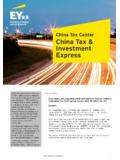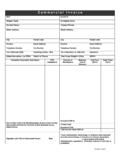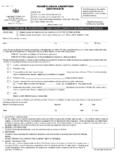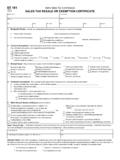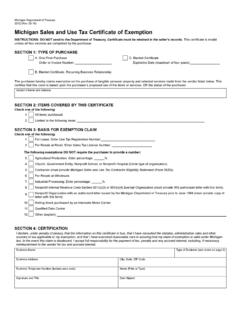Transcription of Increase in De Minimis Safe Harbor Limit for …
1 Increase in De Minimis Safe Harbor Limit for Taxpayers Without an Applicable Financial Statement Notice 2015-82. PURPOSE. This notice provides an Increase in the de Minimis safe Harbor Limit provided in (a)-1(f)(1)(ii)(D) of the Income Tax Regulations for a taxpayer without an applicable financial statement ( AFS ). BACKGROUND. On September 17, 2013, the Treasury Department and the Internal Revenue Service ( IRS ) issued final regulations under , , (a)-1, (a)- 2, and (a)-3 ( 9636, 2013-43 331, 78 Fed. Reg. 57686) to provide guidance on the application of 162(a) and 263(a) of the Internal Revenue Code ( Code ) to amounts paid to acquire, produce, or improve tangible property ( final tangible property regulations ).
2 The final tangible property regulations are applicable to taxable years beginning on or after January 1, 2014. Optionally, a taxpayer may choose to apply the final tangible property regulations to taxable years beginning on or after January 1, 2012, and before January 1, 2014. In addition to clarifying the requirements under 162(a) and 263(a), the tangible property regulations also include several simplifying provisions that are elective and prospective in application, and are intended to ease taxpayers' compliance with the regulations and reduce administrative burden.
3 Section (a)-1(f), for example, -2- provides a de Minimis safe Harbor election that permits a taxpayer to not capitalize, or treat as a material or supply, certain amounts paid for tangible property that it acquires or produces during the taxable year provided the taxpayer meets certain requirements and the property does not exceed certain dollar limitations. If such requirements are met, amounts paid for the qualifying property generally may be deducted under 162, provided the amount otherwise constitutes an ordinary and necessary business expense in carrying on a trade or business.
4 See (a)-1(f)(3)(iv). Under (a)-1(f)(1)(ii)(D), a taxpayer without an AFS (as defined in (a)-1(f)(4)) may elect to apply the de Minimis safe Harbor if, in addition to other requirements, the amount paid for the property subject to the de Minimis safe Harbor does not exceed $500 per invoice (or per item as substantiated by the invoice). In contrast, under (a)-1(f)(1)(i)(D), a taxpayer with an AFS may elect to apply the de Minimis safe Harbor if, in addition to other requirements, the amount paid for the property does not exceed $5,000 and the taxpayer treats the amount paid as an expense on its AFS in accordance with its written accounting procedures.
5 A larger safe Harbor limitation is reasonable for a taxpayer with an AFS because an AFS provides independent assurance that the taxpayer's de Minimis policies are consistent with the requirements of generally accepted accounting principles ( GAAP ) and do not materially distort the taxpayer's financial statement income. The de Minimis safe Harbor provided under (a)-1(f) was intended as an administrative convenience whereby a taxpayer is permitted to deduct small dollar expenditures for the acquisition or production of new property or for the improvement of -3- existing property, which otherwise must be capitalized under 263(a).
6 The de Minimis safe Harbor does not Limit a taxpayer's ability to deduct otherwise deductible repair or maintenance costs that exceed the amount subject to the safe Harbor . The safe Harbor merely establishes a minimum threshold below which all qualifying amounts are considered deductible. Consistent with longstanding federal income tax rules, a taxpayer may continue to deduct all otherwise deductible repair or maintenance costs, regardless of amount. After the final tangible property regulations were issued, the Treasury Department and the IRS received numerous letters from representatives of small business taxpayers requesting that the Treasury Department and the IRS Increase the de Minimis safe Harbor Limit for taxpayers that do not have an AFS.
7 In Rev. Proc. 2015- 20, 2015-9 694, the Treasury Department and the IRS formally requested comments on whether it is appropriate to Increase the de Minimis safe Harbor Limit provided in (a)-1(f)(1)(ii)(D) for a taxpayer without an AFS to an amount greater than $500, and, if so, what amount should be used and the justification for considering that amount appropriate. DISCUSSION. The Treasury Department and the IRS received more than 150 comment letters suggesting an Increase in the amount of the de Minimis safe Harbor Limit for taxpayers without an AFS. The suggested increased amount ranged from $750 to $100,000.
8 Generally, commenters wrote that the $500 limitation was too low to effectively reduce the administrative burden of complying with the capitalization requirement for small -4- business taxpayers that frequently purchase tangible property in their trades and businesses. Commenters noted that the cost of many commonly expensed items (for example, tablet-style personal computers, smart phones, and machinery and equipment parts) typically surpass the current $500 per item or invoice threshold provided in (a)-1(f)(1)(ii)(D). Commenters also stated that the $500 threshold does not correspond to the financial accounting policies of many small businesses, which frequently permit the deduction of amounts in excess of $500 as immaterial.
9 Commenters noted that without an Increase in the de Minimis safe Harbor Limit for taxpayers without an AFS, a capitalization threshold in excess of $500 can only be substantiated by establishing that a taxpayer's policy results in the clear reflection of income for federal income tax purposes, resulting in additional burden and uncertainty for taxpayers. Finally, many commenters expressed concern regarding the disparate treatment of taxpayers with an AFS compared to those without an AFS under the safe Harbor requirements, stating that obtaining an AFS is cost prohibitive for many small businesses and does not adequately justify the substantially lower de Minimis ceiling for these taxpayers.
10 Section (a)-1(f)(1)(ii)(D) permits the IRS to change the safe Harbor Limit to an amount identified in published guidance in the Federal Register or in the Internal Revenue Bulletin (see (d)(2)(ii)(b)). Having considered taxpayers' comments, the goal of the final tangible property regulations to reduce administrative burden, and the concern that taxpayers' methods of accounting clearly reflect income, the (a)-1(f)(1)(ii)(D) de Minimis safe Harbor -5- limitation for a taxpayer without an AFS is increased from $500 to $2,500. EFFECTIVE DATE. This Notice is effective for costs incurred during taxable years beginning on or after January 1, 2016.












